.jpg) |
| Athelhampton House |
Today Athelhampton is one of England’s finest Tudor mansions. It was pretty impressive when it was built, but a visitor in the Regency period would have seen it as a tired, rundown relic of a farmhouse. Little more than an ornate barn.
Not that many people would have visited Athelhampton. Despite King George III regularly passing nearby on his way to and from Weymouth, the house wasn’t on the itinerary of anyone of any consequence. It was lived in by tenant farmers—hence the livestock roaming the halls.
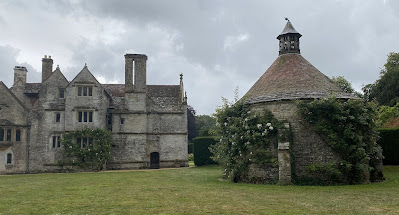 |
| Rear view of Athelhampton House and the dovecote (2023) |
A house protected by the pigs
In July 2023 Andrew and I were invited to tour Athelhampton, which has been under new ownership since 2019. The house, which was already ancient by the time of the Regency, offers an alternative narrative to what we associate with the grand halls of the period.
Athelhampton stands out as a historic mansion, because it’s not built in the classical style we associate with the Georgians. It lacks the symmetry and bold pillars of so many grand houses. The Tudor styling and unbalanced frontage would have looked quaintly old-fashioned to the Regency eye.
That the house survived for so long (the Great Hall is now over 530 years old) is probably because Nicholas Martyn died with no male heir in 1595. He was the grandson of the house builder, Sir William Martyn, who put it up in 1485.
Nicholas Martyn had four daughters, each of whom inherited a quarter of the property. Because no one person owned the house, no one was able to make major changes to it. By 1700, ownership had been consolidated to a three-quarter and a one-quarter share, split between two families, each of which owned other estates. Neither family lived at Athelhampton, preferring to rent the property to farmers.
This relegation in status protected the architecture we admire today. Had a wealthy Georgian had sole control over Athelhampton, it’s likely he would have wanted to make a statement by tearing it down, and rebuilding it in a more fashionable style. Hence, it’s the pigs that protected the house.
Ironically, it was also a farmer who helped the house survive into the 21st century. Tenant farmer George Wood bought the largest share of the Athelhampton inheritance in 1848. In 1861 he acquired the other share to become the first sole owner in over 250 years.
In 1891 the Woods sold the house to Alfred Cart de Lafontaine. He began the process of restoring the house to its former glory, and laid out the elegant gardens. This work, and that of subsequent owners, protected the house from the rampant demolition that destroyed so many historic buildings in the 20th century.
 |
| One of the gardens at Athelhampton (2023) |
Regency Athelhampton
During the Regency (1811–1820) Athelhampton was owned by Catherine Tylney-Long (1789–1825), an heiress believed to be the richest commoner in England. She inherited a huge portfolio of properties as a teenager in 1805, giving her the nickname of “The Wiltshire Heiress”.
As already mentioned, at the time the house was leased to farmers, and it stayed that way during her ownership. She probably never visited the house.
 |
| Catherine Tylney-Long by an unknown artist |
A close brush with royalty
Despite being incredibly wealthy, Catherine Tylney-Long’s story is tragic.
She also came close to being queen. She was courted by William, Duke of Clarence, third son of King George III, who was nearly 25 years her senior. The press mocked him for pursuing her.
The Duke of Clarence became William IV in 1830. Had Catherine married him, she would have become queen, if—and this is an extremely big if—George III had given his permission for the marriage. With that permission, the marriage would have been legal, and the eldest of their children would have become monarch after William, not his niece Victoria.
 |
| The Disconsolate Sailor (1811) by Argus (Charles Williams) |
But Catherine turned down the Duke of Clarence and accepted a proposal from William Wellesley-Pole, a man with a wild reputation. They married in March 1812. William continued his outrageous lifestyle of womanising and gambling, spending much of her wealth.
She died in 1825, aged just 35. The newspapers reported:
To her, riches have been worse than poverty; and her life seems to have been sacrificed, and her heart ultimately broken, through the very means which should have cherished and maintained her in the happiness and splendour which her fortune and disposition were alike qualified to produce.1
Catherine was also connected with another major figure of the Regency era, the Duke of Wellington. Her husband was the great man’s nephew. It was Catherine’s son who sold Athelhampton to the tenant farmer, George Wood, in 1848, to pay off some of his father’s debts.
What you can see at Athelhampton today
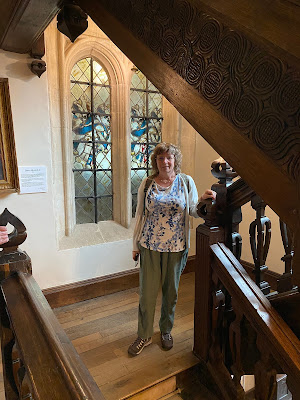 |
| Rachel at Athelhampton House (2023) |
Our comprehensive tour of Athelhampton House took several hours, as the extremely knowledgeable manager of the site—Owen Davies—showed us around. A new owner bought the house in 2019 and implemented a series of renovations. He opened up new areas of the house, and visitors are now allowed to enter rooms which previously you could only see from the doorway.
The previous owner auctioned off the house contents separately, and so apart from a few items, such as the portrait of Princess Sophia, which the new owner was able to secure, most of what you see today has come into the house since then. However, much of it is authentic period furniture, and the rooms have been set out to represent different periods in Athelhampton’s history.
 |
| Portrait of Princess Sophia by Robinson after Sir William Beechey (1820) |
There is also more emphasis on one of Athelhampton’s most famous visitors—author Thomas Hardy.
These are some of the highlights:
Tudor doors
 |
| Tudor door, Athelhampton House (2023) |
The Tudor Great Hall, with its impressive, beamed ceiling and Oriel window.
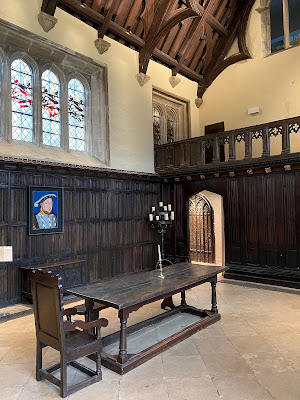 |
| Tudor Great Hall, Athelhampton House (2023) |
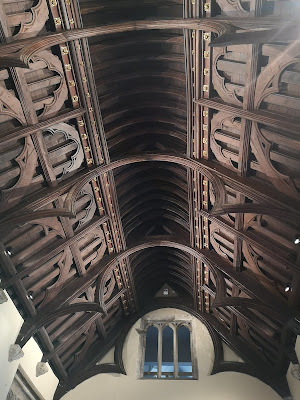 |
| Ceiling of the Tudor Great Hall, Athelhampton House (2023) |
 |
| Oriel Window in Tudor Great Hall, Athelhampton House (2023) |
The Green Parlour, where author Thomas Hardy was dining in 1914 when a telegram arrived announcing the beginning of World War I.
 |
| Green Parlour, Athelhampton House (2023) |
The recently restored Elizabethan Kitchen.
 |
| Elizabethan Kitchen, Athelhampton House (2023) |
The Marriage Chamber, with its original fireplace, showing the motifs of Sir William Martyn and his first wife, Isabel Farringdon—the ape and the unicorn—and an Elizabethan tester bed.
 |
| Marriage Chamber, Athelhampton House (2023) |
 |
| Marriage Chamber, Athelhampton House (2023) |
The Armada Chest in the King’s Room—a late 16th century portable safe.
 |
| Armada Chest in the King's Room, Athelhampton House (2023) |
The Library—originally Elizabethan bedrooms, there is a hidden door in the wood panelling leading to the staircase that comes out in the Great Chamber. The room is dominated by a billiard table dating from 1915.
 |
| The Library, Athelhampton House (2023) |
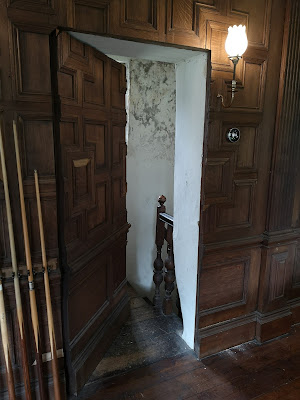 |
| Secret door in the Library, Athelhampton House (2023) |
The Great Chamber—used to store grain in the 1850s, the room is lined with Elizabethan oak panels, with Italian carving over the fireplace. And it hides a secret—a door leading to a priest hole and a staircase up to the Library, which was originally a bedroom.
The magnificent plaster ceiling is an early 20th century replica of the pattern used in the Globe Room in the Reindeer Inn, Banbury, Oxfordshire, thought to be where Oliver Cromwell held meetings during the English Civil War.
 |
| Italian carved panels in the Great Chamber, Athelhampton House (2023) |
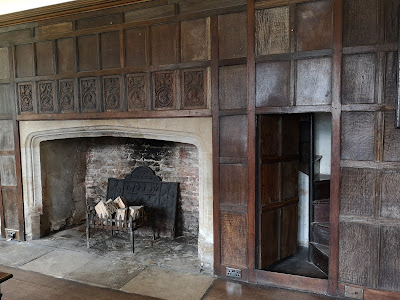 |
| Secret door in the Great Chamber, Athelhampton House (2023) |
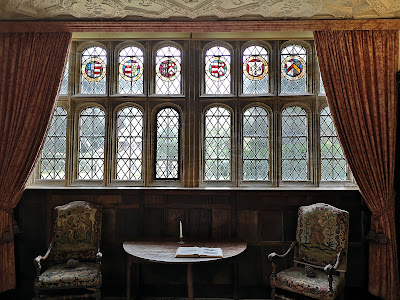 |
| The Great Chamber, Athelhampton House (2023) |
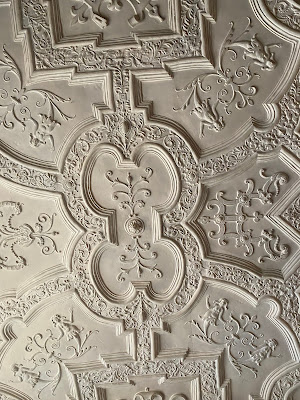 |
| Ornate plaster ceiling in the Great Chamber, Athelhampton House (2023) |
Gardens
 |
| Gateway to one of the gardens at Athelhampton (2023) |
 |
| One of the gardens at Athelhampton (2023) |
Find out about visiting Athelhampton here.
You can see what the house was like under the previous ownership on my original blog here.
If you have enjoyed this blog and want to encourage us and help us to keep making our research freely available, please buy us a virtual cup of coffee by clicking the button below.
Note
- Englishman, 18 September 1825.


Thank you for publishing these marvelous pictures! Your description, too, was wonderful!
ReplyDelete